Chapter 10 Transport

Download a PDF version of this chapter [PDF, 990 KB]
Chief Executive of Waka Kotahi NZ Transport Agency
Chief Executive of the Civil Aviation Authority
Chief Executive of Maritime New Zealand
By 2035, Aotearoa New Zealand will have significantly reduced transport-related carbon emissions and have a more accessible and equitable transport system that supports wellbeing.
| Projected emissions without the initiatives in this plan | 66.5 Mt CO2-e |
| Projected average annual emissions without the initiatives in this plan | 16.6 Mt CO2-e |
| Projected percentage of total gross emissions without the initatives in this plan | 21 per cent |
| Estimated emissions reduction from the initatives in this plan | 1.7 to 1.9 Mt CO2-e |
Transport is one of our largest sources of greenhouse gas emissions and is responsible for 17 per cent of Aotearoa New Zealand’s gross emissions.
More sustainable transport options can also reduce the cost of transport and reliance on global fossil fuel markets.
Decarbonising the transport system will deliver better transport for everyone in Aotearoa New Zealand and contribute to more vibrant, resilient and prosperous places to live, work and visit. It will reduce our reliance on volatile global energy markets.
By 2035, all new cars will be low or zero emissions, and significant progress will have been made to decarbonise more challenging transport modes, such as trucks, ships and planes. This will result in vehicles that are cleaner and more affordable to run, and reduce the significant harm caused by air and noise pollution.
More people will be able to walk, cycle and use public and shared transport options, particularly in our largest urban areas. This will reduce congestion, air pollution and noise, create better places to live in, and support public health and wellbeing.
As a result, we will have a more sustainable, inclusive, safe and accessible transport system that better supports economic activity and community life.
Achieving this vision will require transformational changes that will be challenging. The Government has a clear role to play, but this vision requires local government, Māori, businesses and communities to do their part.
The challenge is to deliver change at the pace and scale required to achieve the necessary reduction in transport emissions, while also giving all New Zealanders access to the significant co-benefits that will accompany our transition to a low-emissions transport system.
Transport is one of our largest sources of greenhouse gas emissions. It is responsible for:
To reach net-zero long-lived emissions by 2050, we need to largely decarbonise transport. Urgent action and system-wide changes are needed to put our transport emissions on the trajectory to a low-emissions future.
The current transport system is also inequitable. Māori, Pasifika, disabled people, low-income households, women, older people, children and rural communities are often underserved by the transport system. They are also overburdened by related negative impacts, such as deaths, serious injuries and illness from transport crashes, and pollution. To ensure an equitable transition, the transport system needs to be more inclusive and affordable.
* These figures are an estimate of 2019 transport emissions based on New Zealand's Greenhouse Gas Inventory 1990–2020
References to current transport emissions are based on the 2019 greenhouse gas estimates from New Zealand’s Greenhouse Gas Inventory 1990–2020, published in April 2022. Transport emissions estimates are around 10 per cent lower than New Zealand’s previous Greenhouse Gas Inventory 1990–2019, published in April 2021. This drop is due to a reallocation of fuel use from the transport sector to the rest of the energy sector and implies that underlying road transport fuel efficiency is higher than previously estimated. Projected emissions for transport, including emissions reductions, are based on the previous 1990–2019 Greenhouse Gas Inventory, because the transport models used could not be updated in time for publication. This means that projected transport emissions and emissions reductions are likely to be lower when the Government revises its projections using the latest inventory data.
This section outlines the Government’s approach to reducing transport emissions. While the immediate focus is on action over the next three years, this approach lays the foundation for the next 30 years. Three focus areas guide this approach to reducing transport emissions:
The Government has set four transport targets that will support these focus areas and align with achieving the sector sub-targets for transport.* This is approximately equivalent to a 41 per cent reduction in transport emissions by 2035 from 2019 levels.**
The targets provide guidance on how much effort is required to reduce transport emissions across the system and will shape our policy and investment decisions to support the scale and pace of change required.*****
To achieve these targets, the Government must work with key partners to take the initial actions outlined in this chapter over the first emissions budget period (2022–25). This includes partnering with Māori to incorporate Māori-led solutions and supporting communities and businesses for an equitable transition.
Further action and refinement will be needed in the second (2026–30) and third (2031–35) emissions budgets depending on how we are tracking.
Achieving the transport targets also depends on complementary policies, such as a strong New Zealand Emissions Trading Scheme (NZ ETS) price to incentivise low-emissions fuels, and changing the way we plan our towns and cities to make it easier and safer for people to reduce car travel.
Many of the actions in this plan will also support an equitable transition, including by making clean and affordable transport options more accessible for low-income and transport disadvantaged New Zealanders.
* Sector-sub targets are based on the Climate Change Commission’s demonstration path that is benchmarked to New Zealand's Greenhouse Gas Inventory 1990–2019, as opposed to the 1990–2020 Inventory.
** This 41 per cent is calculated using the New Zealand Greenhouse Gas Inventory 1990–2019, as opposed to the latest 1990–2020 inventory.
*** Kilometres refers to Vehicle Kilometres Travelled (VKT).
**** This target for freight transport includes emissions from trucks, rail and ships. It excludes light vehicles and aviation.
***** The targets are closely interrelated. The projected impact of achieving each target is conditional on achieving one or more of the others. Target 1 reflects a change compared to the Te Manatū Waka Ministry of Transport’s baseline projection for 2035. Target 2 is against the 2035 fleet projection, given the effects of achieving Target 1 on the size of the fleet. Target 3 is compared to the level of emissions from freight transport in 2019. Target 4 is conditional on undertaking activities as part of achieving Targets 1 to 3 that would bring about lower projected liquid fossil fuel use in 2035.
Figure 10.1 highlights some of the key actions in this plan that will put Aotearoa on track for achieving the four transport targets set for 2035.
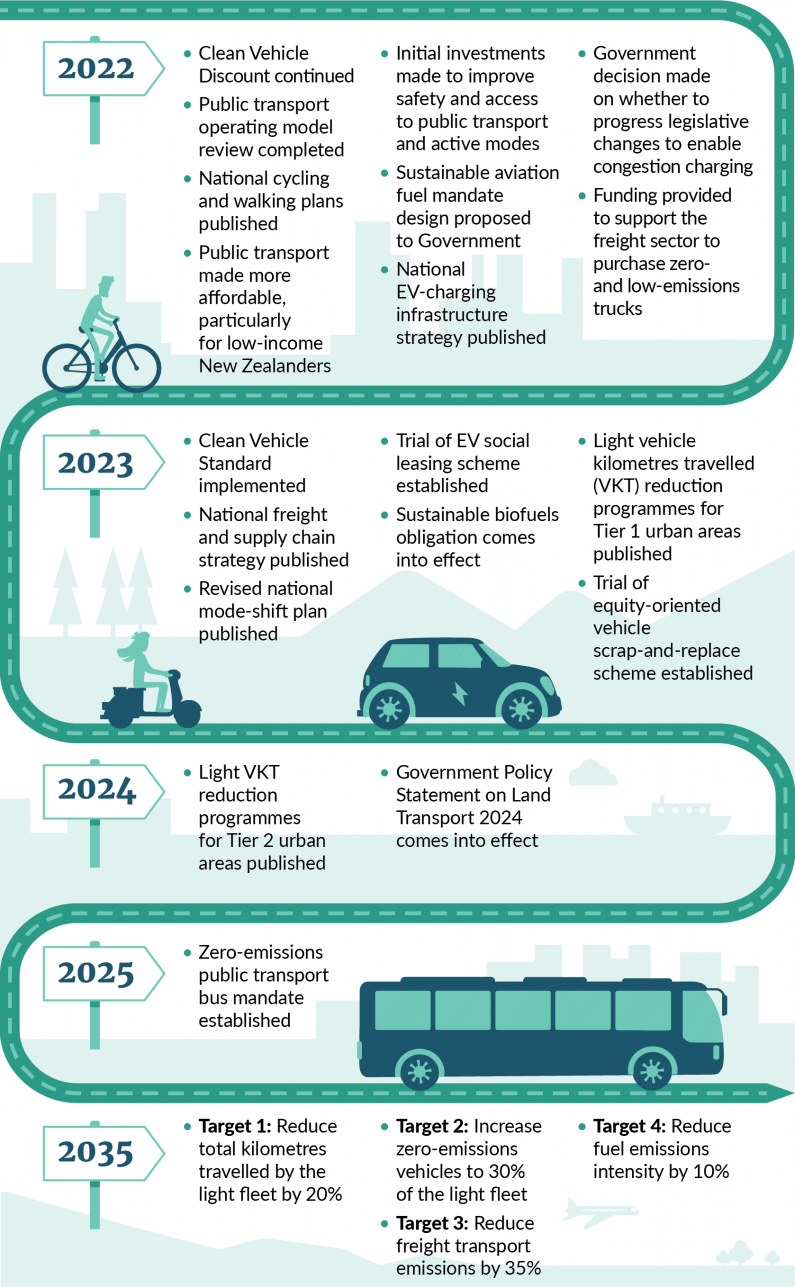
2022
2023
2024
2025
2035

2022
2023
2024
2025
2035
Reduce total kilometres travelled by the light fleet by 20 per cent by 2035 through improved urban form and providing better travel options, particularly in our largest cities.
The amount people travel in fossil-fuelled vehicles is at the heart of the transport emissions challenge. We cannot rely on just decarbonising the vehicle fleet quickly. Improving urban form, offering better transport options, and using other demand management levers to reduce VKT by cars is vital. Most of this reduction needs to occur in our largest cities, where people are more likely to have transport options other than travelling by car. These measures can also deliver significant benefits beyond reducing emissions, such as improving travel choice and accessibility, better health and safety, and less congestion.
The Queenstown Package reprioritises existing infrastructure to provide dedicated public transport and active mode infrastructure for communities in the Queenstown area. A response to growing population and existing traffic congestion, it is part of the New Zealand Upgrade Programme.
The NZ$115 million package will deliver the infrastructure needed for more reliable public transport services, and provide more travel options that are safer, healthier and better for the environment. When aligned with spatial planning, it will lead to more housing choices, better transport options and well-designed neighbourhoods that provide for everyday needs.
Reducing transport emissions offers major opportunities to also create better places for people to live, work and play.
To deliver this, land-use planning and infrastructure investments will allow more people to live in existing urban areas, where social and economic opportunities are greatest. Frequent and rapid public transport services will form the backbone of major urban developments and be well-connected with walking and cycling networks (see chapter 7: Planning and infrastructure).
New Zealanders need better public transport choices and it must be safer and easier to travel by active modes. Increasing travel by public transport, walking and cycling, will see significant benefits for New Zealanders beyond reducing emissions. This includes improved travel choice and accessibility, better health and safety, and less congestion.
* Tier 1 covers Auckland, Hamilton, Tauranga, Wellington, and Christchurch. Tier 2 covers Whangārei, New Plymouth, Napier Hastings, Palmerston North, Nelson Tasman, Queenstown, and Dunedin.
** ‘Transport disadvantage’ includes people who have limited options to participate in everyday activities because of a lack of transport choices, and people who overcome lack of transport choice by paying more than they can reasonably afford for mobility. These people include disabled people, who are more likely than others to experience transport poverty, and have specific accessibility needs, which reduces their choices.
Pricing tools, such as congestion charging, provide an opportunity to reduce emissions, improve congestion and support shifts to public and active transport modes. Enabling congestion charging could encourage better use of our transport system and reduce the need for expensive and emissions-intensive infrastructure investments.
New highways and road expansion projects are sometimes needed to support urban and housing development and the efficient movement of freight, but they can increase emissions by inducing more private vehicle travel. Further investment that expands roads and highways needs to be consistent with transport targets and avoid inducing further travel by private vehicles.
Nature-based solutions refers to the sustainable management and use of natural features and processes to tackle socio-environmental challenges, such as climate change.
For transport, opportunities to apply nature-based solutions at a local, regional and national scale can reduce transport emissions and improve climate adaptation as well as biodiversity outcomes.
Increase zero-emissions vehicles to 30 per cent of the light fleet by 2035.
Two-thirds of transport emissions come from the light vehicle fleet. Alongside reducing reliance on light vehicles, decarbonising the light vehicle fleet is critical for meeting our targets.
Aotearoa has begun to decarbonise its light vehicle fleet. The Clean Vehicle Standard and Discount Scheme has already provided 14,500 (as at 11 April 2022) rebates to vehicle buyers and helped to triple monthly EV sales (from 500 per month to 1,500). EV sales are 12.1 per cent of sales of brand new passenger vehicles so far in 2022.* Light EVs are also exempt from paying road user charges.
The Clean Car Sector Leadership Group has also been established to advise on measures to accelerate the uptake of clean vehicles, including measures to address future supply constraints. Where practicable, government agencies are transitioning to low-emissions fleets.
We need to do more to encourage the rapid uptake of low- and zero-emissions vehicles and, to ensure an equitable transition, make them accessible for more New Zealanders.
* Year to date January–March.

Ohomairangi Trust is a kaupapa Māori early-intervention service based in Māngere, Auckland. The Trust helps families in the community by providing parent training courses, transport, meals and childcare.
When vehicles in the Trust’s petrol fleet needed renewal, the team opted for an electric fleet to reduce their carbon footprint and explore potential cuts to running costs. Electric vehicles (EVs) would work perfectly for the short urban trips that make up most of their travel and whānau transport and home visits.
In 2018, with co-funding from the Low Emission Transport Fund (managed by the Energy Efficiency and Conservation Authority), the Trust bought six EVs, a mixture of new and used. Choosing mostly used vehicles helped keep costs down.
The 80–120 km range of the Nissan Leaf and Nissan eNV200 van is ideal for the Trust’s teachers, therapists and specialists, and their short local journeys. The 200 km range of the Hyundai Ioniq enables work in the regions.
To get staff onside, the Trust’s transport coordinator created his own driver training manual and trained each staff member individually. Some staff were nervous at first. They worried about the unfamiliar technology and being stranded with a dead battery. But adaptation was easy, and staff soon appreciated the quietness, reliability and ease of recharging.
The EVs are running well and have significantly reduced the Trust’s running costs. Petrol was costing up to NZ$2,000 a month and rising. Now they spend significantly less, even on charging. The Trust no longer pays road user charges because light electric vehicles are exempt until 2024. Servicing and registration costs have fallen compared with equivalent petrol vehicles. Maintenance costs are minimal, with no tune-ups, cambelts or oil changes needed.
The Trust has shown that investment in EVs is great for the environment and operating costs. The Trust has since bought two more electric cars. Their fleet is currently half electric, with all-electric being the long-term goal. Robert says, “We cannot go on driving petrol- and diesel-powered vehicles – the sooner we all change, the better.”
The Government will build on existing policies to accelerate the uptake of low- and zero-emissions vehicles. For Aotearoa households, this will reduce fuel bills and vehicle maintenance costs. Cleaner vehicles will also improve air quality, reducing the significant harm caused by air pollution.
The Government will help low-income and transport-disadvantaged New Zealanders move away from high-emitting vehicles, including by making low-emissions vehicles more accessible. This will help to ensure that all New Zealanders get the benefits of cleaner vehicles.
The Government has already co-funded 1,000 public chargers and will continue to improve EV charging infrastructure across Aotearoa to ensure that all New Zealanders can charge when they need to. Charging infrastructure will be accessible, affordable, convenient, secure and reliable for everyone.
Reduce emissions from freight transport by 35 per cent by 2035.
Reducing emissions from freight transport will be critical to achieving a 41 per cent reduction in transport emissions by 2035. Heavy vehicles, most of which are for freight, emit almost a quarter of our total transport emissions.
Reduce the emissions intensity of transport fuel by 10 per cent by 2035.
Aotearoa also needs to reduce emissions from the fuels used for transport. Low-carbon liquid fuels, such as biofuels, will play a role, alongside electrification, the use of hydrogen and other technologies. Low-carbon liquid fuels are one of the best options for vehicles already in use, and for hard-to-decarbonise transport sectors, such as aviation and coastal shipping.
The Government’s Low Emission Transport Fund has co-funded a range of initiatives to accelerate transport decarbonisation. In early 2022, this included demonstration funding for typically hard to decarbonise sectors, including battery-swap electric truck technology for milk tankers and concrete mixers.
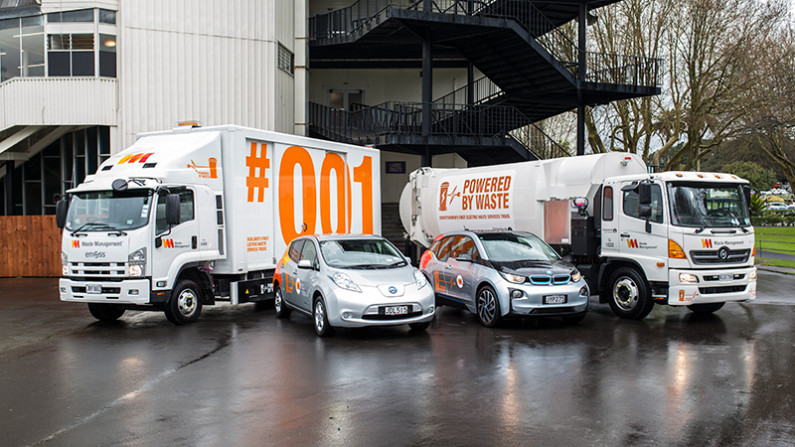
Waste Management New Zealand (WMNZ) is one of Aotearoa New Zealand's leading waste and environmental services provider, offering recycling and resource recovery services, and waste collection and disposal.
In 2016, WMNZ committed to reducing emissions from its fleet. They started to transition some of their diesel fleet and invest in cars to help limit climate change and contribute to Aotearoa New Zealand’s circular economy. Today WMNZ operates one of the largest EV truck fleets in Australasia. It also has 93 electric cars in its light fleet.
WMNZ’s collection trucks each travel an average of 200 km per day. Their work is stop-start — the driver stops to empty each bin — which is perfect for electric. At each stop, the deceleration creates energy that recharges the truck’s on-board batteries. To date, one of those electric trucks has driven about 80,000 km on duty in Auckland. It runs 11 hours and collects 1,200 bins in a day.
WMNZ also captures the gas produced from waste at its landfills. This is converted into electricity and supplies the national grid. In an agreement with the Energy Efficiency and Conservation Authority, WMNZ developed an electric truck conversion workshop in Auckland. Opened in 2018, the workshop works on WMNZ’s fleet and the company helps other companies in Aotearoa with their EV transition too. If fully diesel, WMNZ’s truck fleet would need 10 million litres of diesel a year. Each electric truck that replaces a diesel-powered vehicle, saves 125 litres of diesel a day. Converting the entire WMNZ fleet would save 100,000 litres of diesel a day. Staff have been upskilled to drive, maintain and complete truck conversions in Aotearoa, and manage the fleet’s EVs, keeping the company at the forefront of EV technology globally. WMNZ’s EV programme now includes 27 fully electric trucks, including trucks in Hutt Valley and Dunedin.
Decarbonising the freight sector will be challenging and require consideration of the entire supply chain. Moving towards a more sustainable freight system will reduce harmful diesel emissions, reduce noise pollution, and may provide operating efficiencies to commercial freight businesses.
Decarbonising the bus fleet is increasingly important as more people are encouraged to travel by bus. Cleaner buses will not only reduce emissions – they will improve air quality and amenity in our towns and cities.
Air travel has a role in moving both people and freight to domestic and international destinations. In many cases, air travel is a core mode for inter-city and interregional travel. This means improving its sustainability is critical, alongside improving alternatives to interregional air travel in some places.
The Government has acceded to Annex VI of the International Convention for the Prevention of Pollution from Ships. This is an international agreement to address climate change impacts from shipping. It commits us to implementing future greenhouse gas measures agreed at the International Maritime Organization for Aotearoa-flagged ships and foreign ships operating in our waters.
In 2021, the Government introduced the Sustainable Biofuels Obligation to help overcome the cost and risk barriers to sustainable biofuels uptake. Sustainable biofuels are a renewable, low-emissions fuel source that can be used immediately to reduce our transport emissions.
To decarbonise transport in Aotearoa, the Government will need to provide consistent signals and guidance. Aligning policy and long-term planning with the emissions reduction plan, providing evidence, and supporting people and business with behaviour change, skills and capability are all essential to a rapid and equitable transition.
Cross-cutting and enabling actions are important to help us understand the changes required and the impact of our choices on reducing transport emissions. These will help us to design a stronger and more equitable low-emissions transport system.
This chapter addresses emissions from vehicle use. It does not cover embodied or operational emissions from infrastructure construction, maintenance and operation – some of these emissions are addressed in the chapter 12: Building and construction.
A whole-of-life approach to transport emissions should consider emissions that arise from constructing and maintaining transport infrastructure – such as streets and roads, rail and ports.
The operators of a large proportion of transport infrastructure are Crown agencies, and they will be expected to measure, verify, report and reduce emissions from their operations under the Carbon Neutral Government Programme. This approach also supports a circular economy.
The Government is considering how to manage whole-of-life carbon in the aviation and maritime sectors.
Aotearoa has made a good start to reduce transport emissions. The Government has made several commitments over the past year that have put transport on track to achieve its targets for the first emissions budget period. This includes the Clean Vehicles package, progress on decarbonising the public transport bus fleet, road user charges exemption policies and introducing a sustainable biofuels obligation.
Under high NZ ETS price conditions,* the estimated cumulative impact of these policies is between 1.7 Mt CO2-e and 1.9 Mt CO2-e over the 2022–25 period. Along with changes in the vehicle fleet’s profile and fuel efficiencies over time, these policies are estimated to achieve the emissions reductions required to meet the transport sub-sector target for the first emissions budget period (see figure 10.2).**
The Government is confident that we will achieve the first emissions budget based on this analysis and that New Zealanders will benefit from greater access to low-emissions vehicles, which are cheaper to run and improve the quality of our fleet.
* The high NZ ETS price conditions modelled by the Ministry of Transport reflect the price path used in the Commission’s modelling and are higher than the baseline NZ ETS price settings.
** Emissions reduction estimates are benchmarked to New Zealand's Greenhouse Gas Inventory 1990–2019
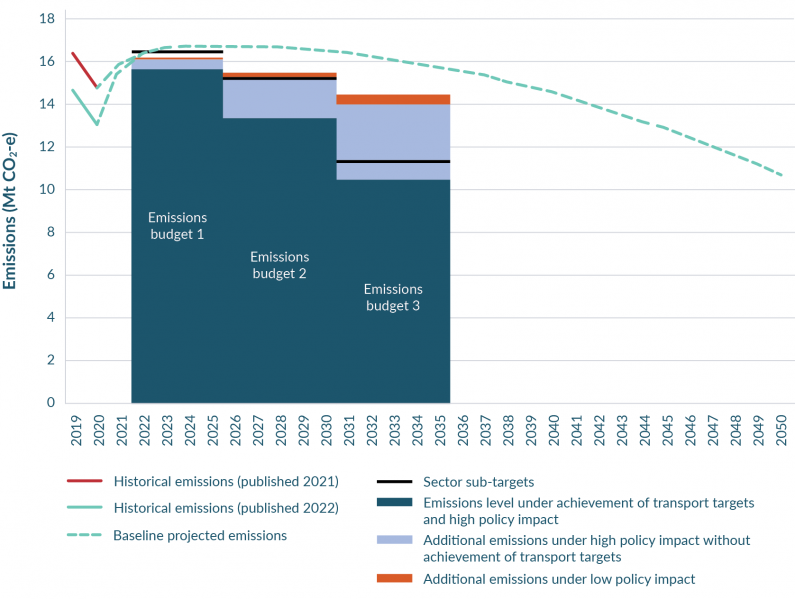
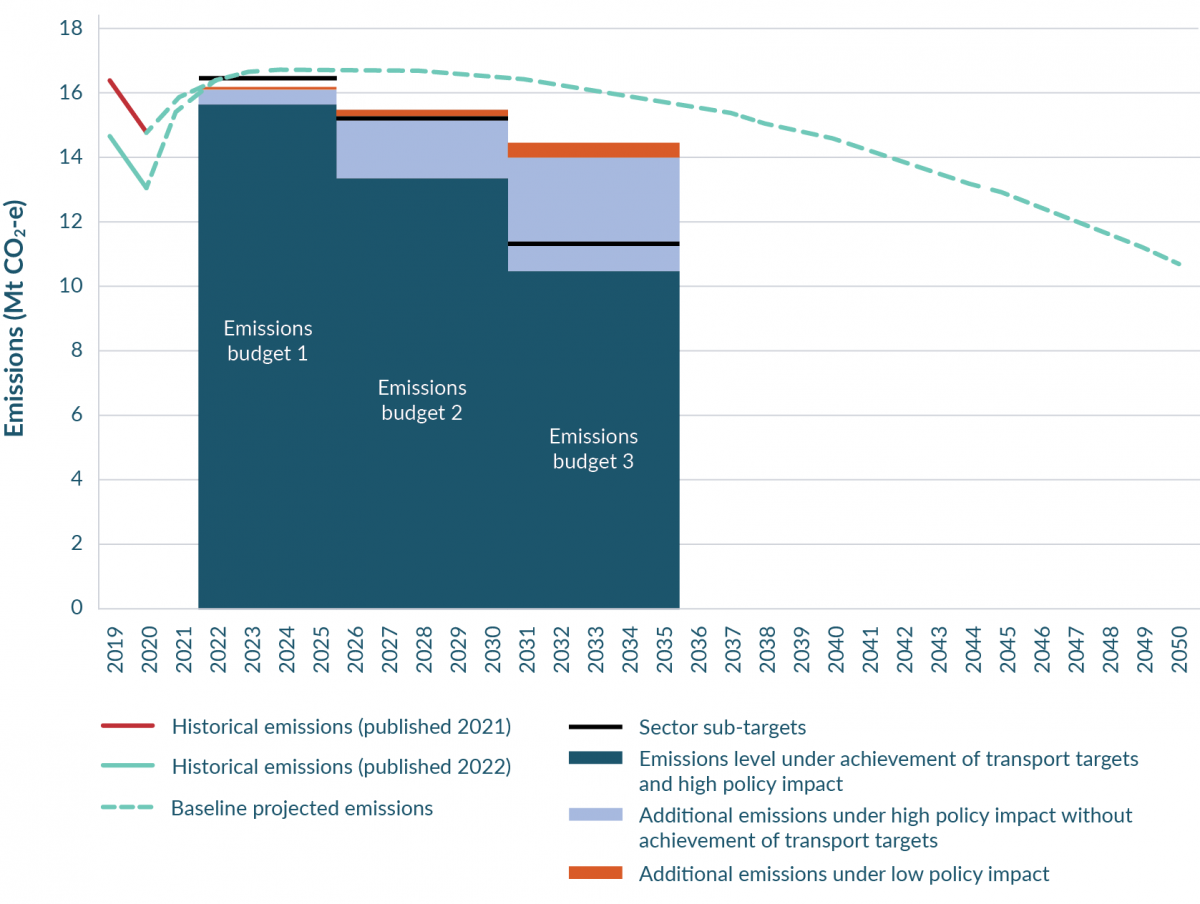
Achieving the transport targets set out in this plan aligns with achieving the subsector targets for transport. This is approximately equivalent to a 41 per cent reduction in transport emissions by 2035 from 2019 levels (see figure 10.2).*
The targets provide guidance on how much effort is required across the system to put us on a pathway to net-zero carbon by 2050. We know from our modelling and international evidence that the actions included in this plan will make significant progress towards the second and third emissions budgets. However, further policy development is needed to determine the specific abatement that many of the actions will achieve.
Further transport actions and refinement will be needed in the second and third emissions budgets depending on how we are tracking.
* This 41 per cent is calculated using New Zealand's Greenhouse Gas Inventory 1990–2019, as opposed to the latest 1990–2020 Inventory.
Figure 10.3 illustrates how each focus area can contribute to achieving the transport sector sub-target.
Baseline changes include the effects of growth in the vehicle fleet and electrification of the vehicle fleet under business as usual. Other key changes include the impacts of the NZ ETS price on electrification and travel. Focus areas 2 and 3 both include the impact of alternative fuels (eg, biofuels).
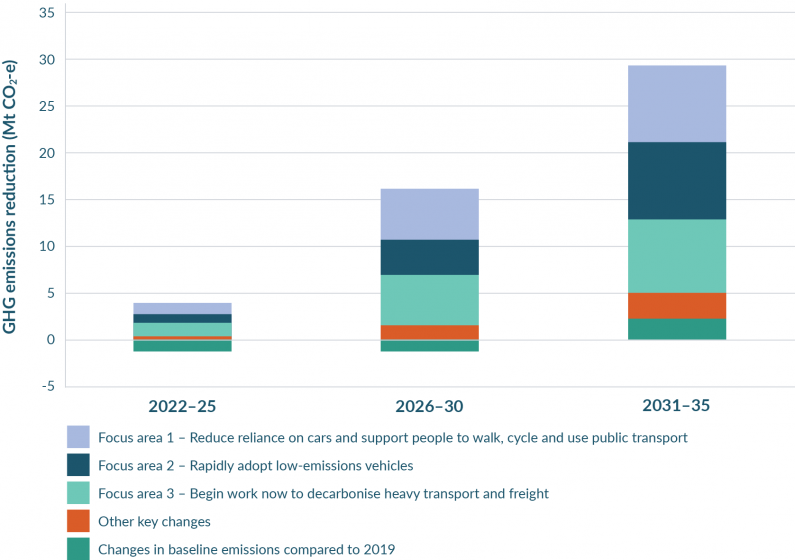
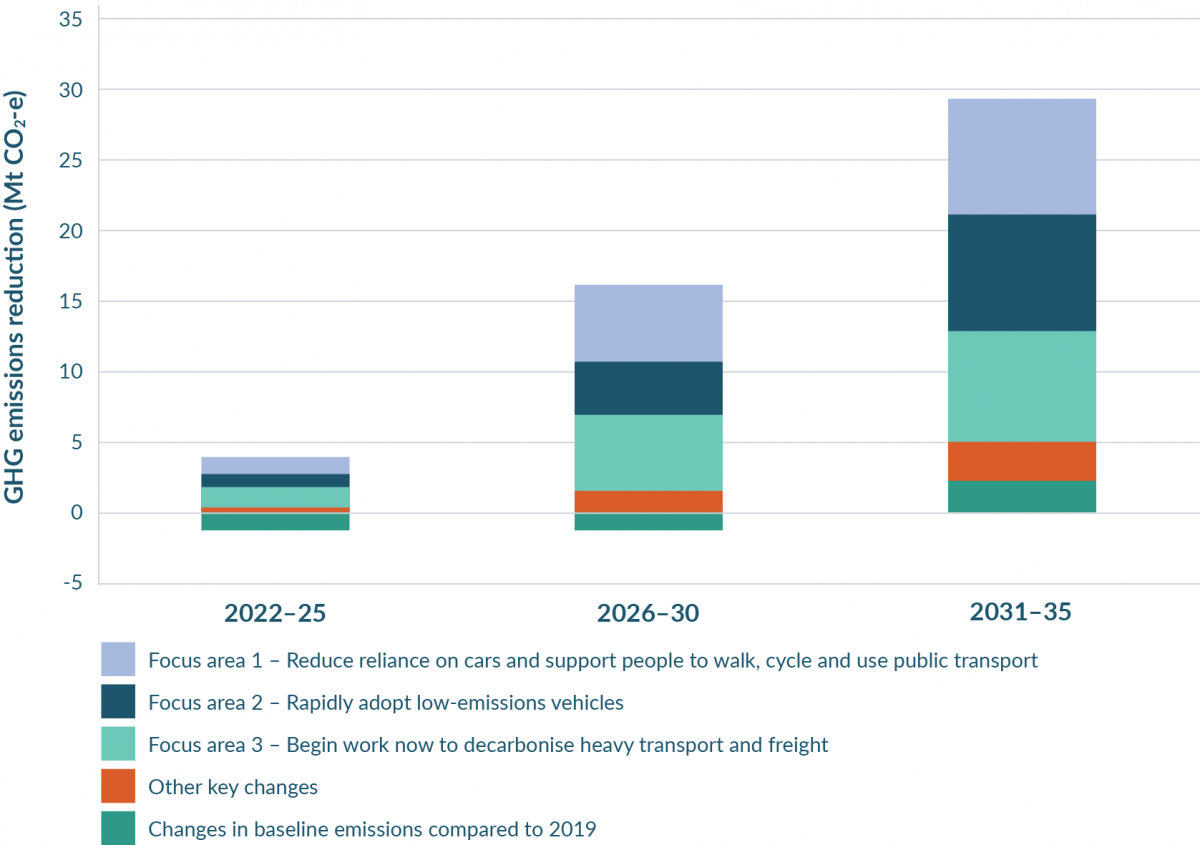
This modelling is based on assumptions about what could happen in the future and how effective our actions could be in making changes. The pace and scale of transport emissions reductions will be affected by a range of factors.
For example, changes in how we live, work and travel could support or hinder our ability to achieve a zero-carbon transport system. Changes to technologies, the availability and cost of alternative fuels, and changes in freight demand will also affect our ability to achieve the transport targets.
The ambitious transport targets that have been set are challenging to achieve. This means that delaying action would result in harder and more costly measures in the future, as well as reducing our chance of achieving the transport targets.
The Government has a clear role to play in reducing transport emissions, but it cannot achieve this alone. A combined effort is required to reduce emissions and build a healthy, safe and accessible transport system.
Local government has a major role in planning and funding regional and local transport. Decisions made by councils about urban form and transport infrastructure, including for active and public transport, determine how we move around our towns and cities. Bold decisions and strong collaboration with central government will be needed to ensure a joined-up approach to decrease transport emissions.
The private sector (businesses) is a major investor and employer in the transport system. Businesses also rely on transport for moving people, goods and services. The private sector can strongly support changes in the system through a range of mechanisms, from education and innovation to investment.
Communities grow the mandate for change and make change happen. All New Zealanders have a stake in our transport system and can influence its direction. This includes community advocacy groups, such as cycling and neighbourhood groups. Change will vary across communities and effort will be needed to ensure all New Zealanders are equitably served.
Māori partnership will be important to deliver equitable transport outcomes for Māori living in urban centres, in rural communities and on marae. Future work on policies must also consider how to mitigate social and equity impacts that transport policies might create for Māori and what solutions could be put in place to address these issues.
The Ministry of Transport will work in partnership with Māori as the policies for this plan and future emissions reduction plans are progressed. This will build partnerships to uphold the principles of Te Tiriti o Waitangi.
The transport sector faces challenges under Aotearoa New Zealand’s changing climate, from managing coastal and flood-prone assets to supporting communities during climate-related events where transport infrastructure is often a lifeline asset.
The transport sector is starting to build climate change adaptation into the planning and design of future infrastructure and has plans in place to respond to emergency events (though the costs of this are continuing to increase).
The significant anticipated investment to reduce and remove emissions could also be used to support adaptation and increase resilience to climate change impacts, and in some cases vice versa. This requires the sector to develop knowledge to support long-term system planning in both mitigation and adaptation together.

Chapter 10 Transport
May 2022
© Ministry for the Environment